

By Jim Hight
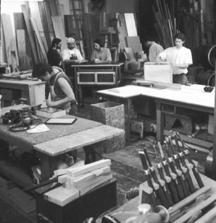
Would you spend $800 for an occasional table? Or $2,400 for an entertainment center? Maybe $4,000 for a dresser?
I wouldn't. When it comes to buying furniture, I shop yard sales. If there's a stick of maple or mahogany in my home, that's news to me.
But after spending a few weeks with hardwood furniture-makers, hearing them talk about designing "cloud lifts" in a craftsman table or watching them pound finely hewn bits of black ebony into a notched mahogany tenon, I've come to understand the appeal of custom hardwood furniture.
I've even felt the stirrings of a desire to own such work myself. But these artisans are not particularly interested in clients like me.
Sure, a woodworker in a dry period would create an inexpensive piece for a customer recently graduated from fiberboard, but the clients they're really after are connoisseurs -- people who have the taste to appreciate custom hardwood furniture and the income to pay for the hours, materials, tools, overhead and experience it takes to create these functional works of art.
Those buyers are rare; some in the business believe as few as 1 percent of Americans are in the market for handmade wood furniture. No wonder making a living in the business is so difficult.
But many North Coast woodworkers are making it, often drawing on each other for support in formal and informal associations and cooperatives. And recently, the talk among these self-employed artisans has centered around a barrier they all face: the Redwood Curtain.
While there are certainly local buyers for their work -- and a few shops able to sell it, such as Plaza Design, Ambiance and Humboldt's Finest -- the real gold is in the hills of San Francisco, Berkeley, Concord, San Mateo, Mill Valley and other Bay Area towns. Woodworkers and interior design professionals say custom furniture fetches as much as 50 percent more in metropolitan areas than on the North Coast.
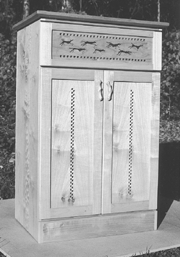
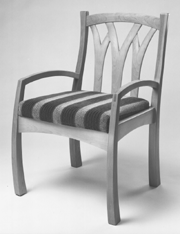
THAT ELUSIVE ADDED VALUE
Several economic development studies -- including a 1988 "Mountain West" analysis -- have pointed to hardwood manufacturing as a potential growth industry in Humboldt County. Not only do hardwood furniture makers use Pacific Northwest trees -- alder, tan oak, black oak, Pacific maple, madrone -- they add great value to these natural resources.
Local sawmills add value to conifer timber by turning it into boards, but when a woodworker turns $200 worth of milled oak or madrone into a $3,500 dining room set, the added-value payoff in wages and profits is much higher.
To nurture the growth of fine hardwood furniture making, two groups have formed within the last year to market Humboldt County-made furniture in the more prosperous provinces beyond the Redwood Curtain.
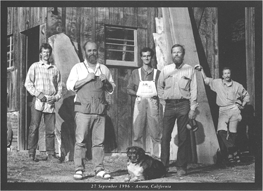
The more aggressive outfit is the Jeffrey Gray Fine Furniture (JGFF) company in Arcata. It was created by Keith Giglio, a Trinidad resident who steered Yakima Products through five years of exponential growth, then worked as a management consultant for local companies before starting JGFF last year.
Jeffrey Gray was a man who in 1979 confided to Giglio, a close family friend, that his career aspiration was to make custom furniture. But after looking into the business side of the trade, Gray decided he wouldn't be able to make a living at it.
Since then Giglio says he studied the market for many years, then designed a cooperatively owned corporation to sell locally produced custom furniture. In a "dreams-come-true" sentiment, he named the company after Gray.
HITTING THE MARKETING TRAIL
Giglio hit the marketing trail in high gear about seven months ago with several hundred thousand dollars in operating capital from investors and lenders. He established a classy storefront office on G Street in Arcata, produced an elegant brochure and mailed thousands of copies to potential furniture buyers.
He's run ads and engineered profiles of JGFF in design magazines. But most of all he's been on the phone and on the highway. I caught up with him while he was driving south from Dublin to San Mateo on Highway 580.
"I'm typically on the road four days a week, all over Northern California," he said on his car phone, "from Monterey and Fresno, north to the Oregon border and east to Sparks, Nev."
His targets are not high-end retail stores, galleries or design showrooms, but interior designers. "People who have this kind of money don't go poking around furniture stores," he said. "They pay someone else to do it.
"In the first six months of being in the market we have collected over $1.25 million of projects to bid on," he said. Those bids have yielded about $100,000 in sales, and Giglio expects several more orders to materialize from that set of bids. The largest project delivered so far: 90 birch chairs completed in March for the Quail Lodge in Carmel.
Giglio projects annual sales will mount to $1 million per year as JGFF saturates Northern California; $3-$5 million as the company penetrates Southern California; and as much as $20 million after it expands eastward to the Mississippi River. "We'll be employing 35 to 40 craftsmen and 160 skilled woodworkers and production helpers."
Right now, however, he acknowledges that his resources are stretched tight as he struggles "for cash and financial strength." He mentioned a "contingency plan" in which he closes the office and works from home. But he also talked excitedly about the response from designers.
"Design professionals are sending us drawing sets, they're starting to call our office, 'I have a project. When are you going to be in town again?' It's starting to happen," Giglio said.
JGFF is two entities: Giglio's marketing end and the worker-owned cooperative of 10 artisans which handles design and production. All 10 are well-established woodworkers at the top of their game. For some, Jeffrey Gray is their first significant marketing foray outside Humboldt County; for others, it's an additional marketing vehicle.
"It's an opportunity to reach a wider audience, a different clientele than we'd normally come into contact with here on the North Coast," said Sam Gregerson, president of the cooperative.
The JGFF woodworkers' cooperative also includes Joseph Amaral, dean of the informal woodworkers' grad school at 10th and L streets in Arcata -- the "White Building," as it's known by area woodworkers. But the building's co-owner, Anthony Kahn, has no need for JGFF's marketing because he already sells most of his work outside the county.
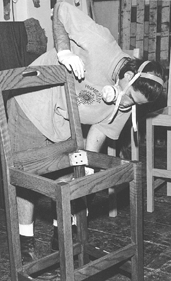 Milton
Sarlis finishing a chair for Joseph Amaral. Photo by Brandi
Easter
Milton
Sarlis finishing a chair for Joseph Amaral. Photo by Brandi
Easter"I've completely ignored the local economy for a long time," he said while finishing a "samurai" hall table made of blond fiddleback maple and brown bubinga. The table's gently curving legs are common to many of Kahn's pieces; an associate once said they reminded him of a samurai sword, hence the name.
Kahn sells throughout the West Coast on the strength of his reputation among buyers, designers and galleries. His "spec" work -- built not on order but as an artistic and marketing display -- is shown by galleries in such upscale locales as Sausalito, Mendocino, Portland, Aspen and Telluride. In October he will show an entire office suite of furniture at the Sculptural Objects and Functional Accessories show in Chicago.
Unlike most woodworkers who cut every angle and rout every groove themselves, Kahn has enough business to employ one full-time woodworker and keep two subcontractors busy, not to mention several part-time sander-finishers.
But Kahn's success in marketing outside Humboldt County is unusual if not unique. Most hardwood furniture makers sell their work primarily inside the county. And like the 10 worker-owners in JFGG, they are eager to establish trade routes to metropolitan areas.
A GUILD FOR WOODWORKERS
While the Jeffrey Gray company is a purely private enterprise, the second new woodworkers' marketing group is using public economic-development money.
Government cash has been spent on similar efforts in the past, but some woodworkers say these programs wasted their time. "If I go to one more meeting where someone tells me to put paint on my birdhouses so they'll sell, I'm going to puke," said one.
Aware of this sentiment, woodworkers John Savaliff and others have formed Humboldt Woodworkers Guild in the belief that the best business advice for woodworkers comes from their peers. The guild received a $45,000 grant from the U.S. Forest Service for a "peer consultancy" program in which they help each other.
"We get woodworkers together in a group and over six weeks each one gets to talk about their business," said Joann Schuch, chair of the 45-member guild. "The others listen and give feedback.... We learn to evaluate each other's business and marketing needs."
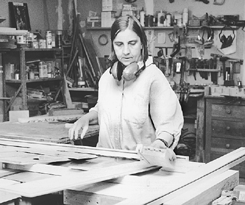
The classes also include lectures by printers and marketing pros chosen by guild members. At the end of the classes each participant leaves with a high-quality printed postcard to sell their work. "We work with them on copy, layout, photos, and we'll even print it," said Schuch.
Schuch doesn't have a pressing need for more business. "I'm booked out through November with custom work." She chose to take a lead role in the guild for the social contact with other woodworkers. "Sometimes I get so isolated in my studio I lose the ability to speak." But she also has business goals.
She's interested in developing a line of furniture and hiring other woodworkers to help produce it. One small custom-furniture shop she's inspired by is the Maine Cottage Co., which specializes in furniture for summer homes. "They started five years ago and now they're at $2.6 million (a year) in sales."
Locally the Wallace & Hinz company is an inspiration to Schuch and other woodworkers; the Arcata company, which builds hardwood bars for customers around the world, employs 20 and generates about $1.2 million in annual sales.
Edmond Deraedt planes a chair rail. Photo by Brandi Easter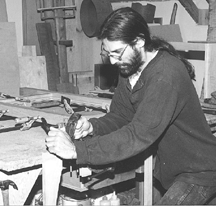
But other woodworkers want to continue working alone, creating one-of-a-kind pieces. "I like the design aspect most of all," said Guild member Edmund Deraedt. "To be able to design and complete a project and have it make sense within itself is the most satisfying part of the work."
The guild hired Julie Fulkerson, former county supervisor and owner of Plaza Design in Arcata and McKinleyville, to coordinate marketing. Fulkerson says she's producing a "knockout" brochure for the guild, and she will organize outreach to architects, designers, retailers and gallery owners. "To publicize North Coast woodworkers, we'll be trying to get articles (about the guild) published in design magazines."
Guild members will display their work July 11 through 13 in the Art of Living exhibit at College of the Redwoods' Wood Fair. The exhibit organizer, interior designer Sarah Traphagen, has mailed invitations to other designers throughout Northern California. And next year the guild plans to organize a group exhibit in the American Craft West show at Moscone Center in San Francisco.
But as it promotes its members, the guild won't become a business entity like Jeffrey Gray. "We'll go down (to the show) as a group under the banner of Humboldt Woodworkers Guild," said Schuch, "but individuals will make their own deals."
Guild members in Southern Humboldt are championing the use of only local tan oak, black oak madrone and other hardwoods that have been harvested in light-touch, non-commercial logging. With help from the Institute for Sustainable Forestry, they're trying to market handmade furniture and other wood products with an environmental pitch.
"Down here most everybody has embraced the idea," said Bud Rogers, a cabinet- and furniture-maker in Redway. "We want to utilize to the highest value the resources from the earth. I've felt badly for a long time about the way industrial timber harvest plans have a negative impact on the watersheds."
Bud Rogers of Southern Humboldt with his eco-friendly tan oak. Photo by Brandi Easter

As we talked Rogers was finishing a southwestern-style dining room set made of tan oak from trees that fell down on his own land. A portable-mill owner sawed the tan oak -- and the madrone that also came down -- into 2,000 board feet. Rogers had it dried in a local kiln (hardwoods require more careful drying than conifers).
Rogers, who was recently elected president of the Garberville-Redway Chamber of Commerce, acknowledged that consumer demand for eco-friendly hardwood furniture isn't exactly surging. "It's a slow process of educating the consumers."
An example of how slow: Rogers' own $6,000 madrone armoire on display at the Mateel Arts Cooperative bears no label telling potential buyers about its environmental pedigree.
Rogers hopes more woodworkers will get into the act, and he's raised his views at guild meetings. But it's a tough sell. The blown-down and diseased trees that Rogers and his philosophical brethren prefer to use are often not well-suited for furniture making. The ideal trees are mature and healthy.
"You can get the biggest, straightest, most primo logs off of a clearcut for the price of pulp," said Michael Jakubal, a portable mill owner in Southern Humboldt. "But we don't want to do that because we don't want to support clearcutting."
The Institute for Sustainable Forestry has a long-term vision of increasing the supply of this wood by bringing more small landowners into the game and thinning cut-over forest tracts where hardwoods have outpaced conifers. (The institute's main project is reopening Wild Iris Forest Products in Piercy to manufacture flooring from tan oak and black oak.)
HARD KNOTS IN THE WOOD
Most woodworkers I interviewed have more moderate points of view than their Southern Humboldt colleagues. Their focus is on surviving in business and excelling at their craft, and they don't guide their work along such activist principles.
Woodworking is probably one of the most difficult careers to choose. Aside from casual labor sanding and finishing, there are virtually no jobs in custom furniture-making. People do it because they love it.
They find someone more experienced to help them get started, then gradually turn it into a living. A writer for a woodworking magazine joked that woodworkers turn professional when they can't squeeze any more of their hand-made furniture into their own house.
"I got my early training by finding the oldest guy in the lumber yard and asking him questions," said Schuch. "My first project was a Morris chair that took one year to build. I'll never sell that chair."
Joseph Amaral remembers the day 21 years ago when he realized "in my heart of hearts, I wanted to make furniture for a living."
"In the beginning I immersed myself in my work.... I worked all kinds of hours, read everything I could get my hands on, ate, breathed and slept woodworking.
"I turn around today and I'm 48 years old.... I'm unmarried and I don't have a family. I'm glad I've done what I've done, but when I see other people (with families), if I have a single regret, that's it."
But regrets aside, Amaral has no hesitation about encouraging and aiding others who are entering or moving up in the field. He's proud of the support he's able to provide to younger woodworkers like Dina Rubiolo who rents space in the White Building.
"I started working here in 1991 sanding and finishing part-time just to get through school," said Rubiolo. "I started looking over folks' shoulders, took a woodshop class at HSU. After that I had full access to the shop. Joseph is very generous and a good teacher."
Last month Rubiolo completed an arts-and-crafts-style table for a clothing shop in San Francisco. The job -- her first Bay Area-bound export -- was applauded by her colleagues. But Rubiolo wanted it known how much Amaral and the others had helped her.
"I couldn't be doing what I'm doing without the support and advice of people here," she said.